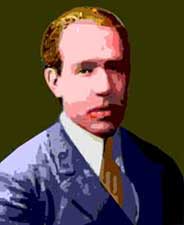
Dimdima
Online Children's Magazine from India

Dimdima
Online Children's Magazine from India
Atoms for Peace
| Fact File |
| Date of Birth-Death : 1885-1962 |
| Country of Birth : Denmark |
| Major Discoveries : Structure of the atom |
|
Writing by the Scientist : 1) The Theory of Spectra and Atomic Constitution, University Press, Cambridge, 1922 2) Atomic Theory and the Description of Nature, University Press, Cambridge, 1934 3) The Unity of Knowledge, Doubleday & Co., New York, 1955. |

He did well at school without ever being brilliant, usually coming third or fourth in a class of about 20 students. If he really excelled at a subject it was, perhaps, physical education. He was an excellent soccer player, yet not as good as his brother. This was Niels Bohr, the world famous Nobel prize winning physicist, the man who proposed the atomic model which is the accepted model even today..
Born to a physiology professor, Niels was exposed to a world of ideas and discussion from the very early childhood at home and developed a deep respect for all who seek deeper knowledge and understanding.
He developed an interest in physics and mathematics from the early days of his education. With no laboratory available in school and college, he would perform experiments in his father’s laboratory. His first work on surface tension was done here, for which he won the Gold Medal in 1906 from the Royal Danish Academy of Sciences. Early in his scientific career, Bohr made numerous contributions to the understanding of atomic structure based on the newly developed branch of physics, quantum mechanics. This was the time when sub atomic particles were being discovered, his teacher Rutherford had proposed a model of atom, but that model was not able to account for the observed properties of the atom. Neils Bohr soon came up with the model of an atom incorporating the ideas of quantum mechanics and that model was able to account for all the properties of atom so brilliantly. It is this atomic model that is accepted even today with only very slight improvements. This work earned him the Nobel Prize for physics in1922.
When the Nazis occupied Denmark, his life became difficult. He had to escape to Sweden in 1943 in a fishing boat; from there he was flown to England. England opened out opportunities of working on the atom bomb. After a few months he went with the British research team to Los Alamos in the United States where they continued work on the project.
Though instrumental in the creation of the atomic bomb, he was deeply concerned with making people aware of the power and destruction that it could unleash. He published a letter to the United Nations in 1950 which asked them to help get rid of nuclear weapons on an international scale. This and his other activities earned Bohr the first U.S. Atoms for Peace Award in 1957. He dedicated his remaining years showing people that nuclear energy must be used in a positive and productive way.
EXPLORE MORE...
Get Help or Give Help.
- Do you have a Science Question?
- Post it here and get the answer.
- Some questions posted by others are not yet answered.
- View those questions and answer them.
Dimdima is the Sanskrit word for ‘drumbeat’. In olden days, victory in battle was heralded by the beat of drums or any important news to be conveyed to the people used to be accompanied with drumbeats.
Bharatiya Vidya Bhavan
K. M Munshi Marg,
Chowpatty, Mumbai - 400 007
email : editor@dimdima.com
Bharatiya Vidya Bhavan
505, Sane Guruji Marg,
Tardeo, Mumbai - 400 034
email : promo@dimdima.com
Dimdima.com, the Children's Website of Bharatiya Vidya Bhavan launched in 2000 and came out with a Printed version of Dimdima Magazine in 2004. At present the Printed Version have more than 35,000 subscribers from India and Abroad.